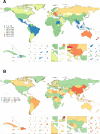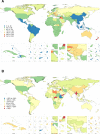Global trends of hand and wrist trauma: a systematic analysis of fracture and digit amputation using the Global Burden of Disease 2017 Study
- PMID: 32169973
- PMCID: PMC7571361
- DOI: 10.1136/injuryprev-2019-043495
Global trends of hand and wrist trauma: a systematic analysis of fracture and digit amputation using the Global Burden of Disease 2017 Study
Abstract
Background: As global rates of mortality decrease, rates of non-fatal injury have increased, particularly in low Socio-demographic Index (SDI) nations. We hypothesised this global pattern of non-fatal injury would be demonstrated in regard to bony hand and wrist trauma over the 27-year study period.
Methods: The Global Burden of Diseases, Injuries, and Risk Factors Study 2017 was used to estimate prevalence, age-standardised incidence and years lived with disability for hand trauma in 195 countries from 1990 to 2017. Individual injuries included hand and wrist fractures, thumb amputations and non-thumb digit amputations.
Results: The global incidence of hand trauma has only modestly decreased since 1990. In 2017, the age-standardised incidence of hand and wrist fractures was 179 per 100 000 (95% uncertainty interval (UI) 146 to 217), whereas the less common injuries of thumb and non-thumb digit amputation were 24 (95% UI 17 to 34) and 56 (95% UI 43 to 74) per 100 000, respectively. Rates of injury vary greatly by region, and improvements have not been equally distributed. The highest burden of hand trauma is currently reported in high SDI countries. However, low-middle and middle SDI countries have increasing rates of hand trauma by as much at 25%.
Conclusions: Certain regions are noted to have high rates of hand trauma over the study period. Low-middle and middle SDI countries, however, have demonstrated increasing rates of fracture and amputation over the last 27 years. This trend is concerning as access to quality and subspecialised surgical hand care is often limiting in these resource-limited regions.
Keywords: burden of disease; descriptive epidemiology; hand injury.
© Author(s) (or their employer(s)) 2020. Re-use permitted under CC BY. Published by BMJ.
Conflict of interest statement
Competing interests: Dr. Jozwiak reports personal fees from TEVA, personal fees from ALAB, personal fees from BOEHRINGER INGELHEIM, personal fees from SYNEXUS, non-financial support from SERVIER, non-financial support from MICROLIFE, and non-financial support from MEDICOVER, outside the submitted work. Dr. James reports grants from Sanofi Pasteur, outside the submitted work.
Figures





References
-
- James SL, Abate D, Abate KH, et al. . Global, regional, and national incidence, prevalence, and years lived with disability for 354 diseases and injuries for 195 countries and territories, 1990-2017: a systematic analysis for the global burden of disease study 2017. Lancet 2018;392:1789–858. 10.1016/S0140-6736(18)32279-7 - DOI - PMC - PubMed
Publication types
MeSH terms
LinkOut - more resources
Full Text Sources
Medical
Research Materials
